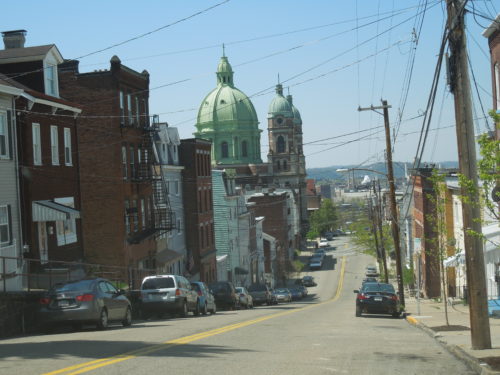
Witamy! Pittsburgh’s Polish Power
February 11, 2015
Greeks in Pittsburgh
February 11, 2015 If cities have heartbeats, than Pittsburgh’s must thump like an oom pah pah band. Although many immigrants have flocked to the Pittsburgh area over the centuries. None have come to the region in greater numbers than the Germans. According to the U.S. Census of 2000, more people in the Pittsburgh area claim German heritage than any other.
If cities have heartbeats, than Pittsburgh’s must thump like an oom pah pah band. Although many immigrants have flocked to the Pittsburgh area over the centuries. None have come to the region in greater numbers than the Germans. According to the U.S. Census of 2000, more people in the Pittsburgh area claim German heritage than any other.
New Beginnings
The first Germans came to the New World in the 1600s and settled in Germantown. This area is known today as Philadelphia. They fought for freedom alongside their fellow British colonialists in the Revolutionary War.
During the early part of the 19th Century, most German immigrants came to the Pittsburgh area for economic opportunities and religious freedom. These new arrivals were mostly farmers and craftsmen.
The Harmonists
One group that came to the area seeking religious freedom was a Christian communal utopian group known as the Harmony Society. It was founded by Johann Georg Rapp in Germany in the 1780s. The Harmonists was a group of nearly 800 farmers and craftsmen who in the end would settle in Butler County. They founded their first settlement there and aptly named it Harmony. Some moved for a brief time to Indiana where they established their second town of Harmony.
The community also took up residence in Western Pennsylvania along the Ohio River in Beaver County. They named this community Economy, and they patterned their society after the early Christian community. They believed that Christ’s second coming was imminent. In 1807 to prepare themselves for His arrival they adopted the rule of celibacy. They were an industrious group but with no future generations. Therefore they had no one to carry on their traditions. The ranks of the Harmonists dwindled and in 1905 the few remaining Harmonists disbanded. The Commonwealth of Pennsylvania acquired six acres of their property in 1916. This National Historic Landmark is now known as Old Economy Village. A visit to Old Economy is like stepping back in time and gives insight into the beliefs and characteristics of this group of German immigrants.
The 48ers
 Many know of the football team the “49ers” from San Francisco. Their name originates from a wave of immigrants coming to the area in 1849 for the gold rush. However a year prior America saw an influx of German immigrants. They logically became known as the “48ers.” Previous immigrants from Germany were farmers and tradesmen. The 48ers were chiefly intellectuals escaping political persecution. By 1860, according to the German Information Center, more than 1.3 million German-born immigrants resided in the United States.
Many know of the football team the “49ers” from San Francisco. Their name originates from a wave of immigrants coming to the area in 1849 for the gold rush. However a year prior America saw an influx of German immigrants. They logically became known as the “48ers.” Previous immigrants from Germany were farmers and tradesmen. The 48ers were chiefly intellectuals escaping political persecution. By 1860, according to the German Information Center, more than 1.3 million German-born immigrants resided in the United States.
Many who settled in the Pittsburgh chose the town of Allegheny along the Allegheny River. It become known as Deutschtown. It was the area along East Ohio Street extending to Troy Hill. In 1907 Pittsburgh absorbed Allegheny. Many different nationalities now inhabit this part of the city. Remnants of its German heritage still thrive at places like Max’s Allegheny Tavern on Suismon Street. It serves delicious, authentic German food in an old tavern that hasn’t changed much over the decades.
German Beer and Song
 What’s German food without German beer? The Eberhardt and Ober Brewery began brewing in 1848 at the foot of Troy Hill on Vinial Street. In 1986, Tom Pastorius founded the Pennsylvania Brewing Company at an old Eberhardt and Ober site. In 2001, their signature brew Penn Pilsner won the Gold Medal from the National Beverage Institute.
What’s German food without German beer? The Eberhardt and Ober Brewery began brewing in 1848 at the foot of Troy Hill on Vinial Street. In 1986, Tom Pastorius founded the Pennsylvania Brewing Company at an old Eberhardt and Ober site. In 2001, their signature brew Penn Pilsner won the Gold Medal from the National Beverage Institute.
With the large number of great German beer you’ll be so happy you will want to sing. You can stroll over a few blocks to the Teutonia Maennerchor on nearby Phineas Street to do just that. It is the largest German Singing Society and Social Club in the area. The Teutonia Maennerchor was founded 150 years ago. In addition to the singing it hosts many activities that reflect on the German culture.
Nearby is the H.J. Heinz Company which was founded in 1896 by noted German Henry Heinz. At the tender age of eight Henry began selling vegetables from his family’s garden. H. J. Heinz is now one the world’s largest and most successful corporations.
Largest Foreign Investor in the Region
Germans and those of German heritage have found Pittsburgh to be a great place to do business. According to Global Pittsburgh, Germany is the largest foreign investor in the region. It cited that “seventy German-owned companies operate approximately 140 establishments in Southwestern Pennsylvania and employ approximately 11,000 individuals.” Bayer, Draeger Safety, and Siemens are only a few of the corporate giants with a presence in Pittsburgh. Even the Hofbrauhaus acknowledged Pittsburgh’s strong ties with its German heritage. It selected Pittsburgh as one of the few cities in America to host a Hofbrauhaus. Crowds flock to the South Side to their iconic Bier Hall to indulge in famed brews and food offerings.
The German Room
 The University of Pittsburgh is famous for its Nationality Rooms located in the Cathedral of Learning. In 1938 The German Room was one of the first rooms dedicated in the Cathedral. Among its many features are stained glass windows that depict characters from Grimm’s Fairy Tales such as Little Red Riding Hood, Hansel and Gretel, and Cinderella.
The University of Pittsburgh is famous for its Nationality Rooms located in the Cathedral of Learning. In 1938 The German Room was one of the first rooms dedicated in the Cathedral. Among its many features are stained glass windows that depict characters from Grimm’s Fairy Tales such as Little Red Riding Hood, Hansel and Gretel, and Cinderella.
With so many claiming German heritage in the area, it may seem odd that there is no German Nationality Day at nearby Kennywood Amusement Park. Perhaps that’s because with so many counting a German ancestor, every day is a German Day at the park. Also unusual is that there is no German Day parade or Saint’s Day parade. Many believe this is because the Germans have integrated into the American culture and simply forgot to set aside a special day to seek notoriety. However, maybe the reason Germans don’t toot their own flugelhorn is that they get enough recognition during the month-long celebration of Oktoberfest.
No matter the reason, Pittsburgh has enjoyed a German-American relationship that can only be described as wunderbar!





